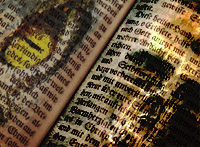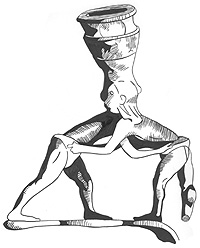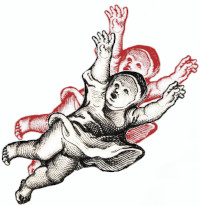Today, June 3, 2025, in G-String, New Jersey, the morning breeze is cool. Last night, as Mary Biscotti and I had coffee after the strip club closed, I in my jacket, her covering her feet with a blanket, she said, “Bullshit!” as she looked into her phone. “James, the weather says its seventy-three out.” What the hell—the weather is lying to me. It’s fucking cold out! I was just on my bike!”
“Mary, this is great: your phone is gaslighting you!”
Just now, as she sits on the back porch in her robe, she is hit by a ray of the sun and says, “Oh, its hot out already! The weather did say the temperature is going up this week.”
Looking at my laptop screen I see a weather report from nearby Burlington, stating, “Temperatures to drop, Saturday.”
Last weekend, in Halifax, PA, as Nero the Pict and I stood drinking whiskey in our jackets he answered my inquiry concerning this article, “Working in HVAC, the winter was slightly cooler, more heat calls. This spring though, still getting some heat calls and a drop off in the air conditioning calls, few people are turning on their air as early as they did. Some of it is conditioning, softening, people becoming more temperature sensitive to being increasingly fat, and as you observed, being shut in during Covid and spending two summers inside. The one thing that is certain, and you know it, my friend, the high temperatures this summer will be statistically manipulated to be a “record high,” and by the end of the summer, after not having had a single hot, sweltering night in The Mid Atlantic, we will continue to be indoctrinated into the Anthropomorphic Global Warming cult.”
We clashed coffee mugs sloshing with good rye whiskey and some evil leprechaun snickered.
Washington
The foothills of the Cascades were slightly cooler and dryer than the norm and in past winters. The most interesting aspect of my late winter/early spring stay was the number of times precipitation changed in the same day, sometimes the same hour, from rain, to sleet, to hail, to snow, to “I don’t know what that is.” Winds are up and trees are down.
Oregon
Portland was dryer and windier than the norm, with one “microblast,” causing much damage.
California
Central California was wetter and cooler by slim margins this spring. Southern California was blissfully breezy. I was told that this year’s weather was normal, and that it is so mild that people become soft in its cozy grip.
Arizona
On this alien planet I was treated to a rare downpour, two of them, bracketing Good Friday, that made the desert bloom.
New Mexico
My host in New Mexico reported a dryer than normal desert winter, with nighttime May temperatures down to 25, preventing early planting, but not unusually cool, that day time temps were already up to 80 at 6,000 feet.
Texas
My train was delayed a day in Texas due to “hail storms that took out tracks” between Fort Worth and Marshall. I liked East Texas. The clouds were ominously billowing on the horizon.
Missouri
This state had the most remarkable clouds, like Portland storm clouds but in wider skies with more sunlight filtering through. The locals told me that it was, like the previous few springs, a little bit cooler than the norm. Flooding was reported over in Kentucky.
Pittsburgh
The day after I arrived in Pittsburgh we had tornadoes, small ones, on the Ohio River, snapping telephone poles in half which hung on the wires. My host; lost half a wild cherry tree in the yard, which Mister Gray and I sawed and copped into firewood. Avery day it rained and alternately the sun shone. It felt like Portland, with numerous micro weather fronts coming and going. It was cooler than normal.
Maryland and Eastern Pennsylvania
The Atlantic side of the Appalachians continued the pattern experienced in Pittsburgh, a lot of heavy looking clouds the like I have never seen coming and going in the east, with slightly cooler days and more chilly nights than reported. Every person I stayed with looked at their phone come night, and especially in early morning, and said, “It feels cooler than that.”
In East Baltimore, in Mid May, it was about 4 on a Friday Afternoon. Megan was getting her shoes on, I waiting on the front walk to take her down to the store. It was supposed to rain all evening and we were bent on beating it. When I arrived I was peeling off my jacket, the sun shining. 45 minutes later, I felt the temperature drop about 15 degrees as a wind out of the south blew down the street. Walking to the gate, I looked at the sky down over the city and saw those strange, dark, billowy clouds with decorative cones wheeling off of the edges, that I had seen since Texas. I returned inside and said, “A storm—we’re staying.”
We stood out under the porch drinking iced tea as the winds picked up and began blowing tarps, trash and lawn chairs down the street. Within minutes it was raining sideways. When the storm cleared, sirens sounded down over the ridge in Old Dundalk. Tornadoes had hit there. One of her friends sent a video of two houses on her street being shredded by a small tornado.
I texted this event to Bob, in Utah and he texted me back that the folks of Northwest Utah had been treated to a vision of “a pillar of light.” None of these events make national news, with the all-seeing eye of the media focused on squabbling between our various leaders.
In my life time, only twice were tornadoes reported in East Central Maryland. Since August 4 2022, twice I have experienced destructive tornadoes taking down trees and houses within a half mile of my host’s habitation. This is very interesting. My instinct, though, is that by the time this article posts in September, that record high temperatures will have been reported and no mention will be made of the absence of sweltering summer nights in Baltimore and like places. I recall, around 1990, having to sleep in a bathtub in the afternoon to rest for the night shift. I remember the times when people lined the summer streets on their porches, for it was too hot inside even by night. Now, in an air-conditioned world, people sleep inside all night and wake surprised, to note that the morning air is more cool than that inside their house.
The following weekend in Halifax, PA, the Saturday before Memorial Day, it rained, then the sun shone, then it rained, then the sun shone, then the wind blew over the canopy, then it cleared totally—then it stormed, drenched us, and the sun shone, and then rained again. We got soaked and sunburned, unable to keep up with the weather changes in that tiny valley, distracted as we were by our knucklehead concerns.
I am keenly interested in how the media refracts the gaslight to distort our increasingly artificial perception. The weather has been easy, the skies more striking with a greater variety of shapes, colors and movement of clouds, particularly in New Jersey. Here, the boaters and fishermen I know have remarked on slightly more rain and rougher seas than normal.
But what is normal?
This part of the country, from 1609, through about 1820, was typically frozen solid from November through March, with rivers easily traversed by foot, horse and cart. In my life time these rivers that drain into the Delaware and Chesapeake Bays have never frozen solid. I count myself lucky to be witness to some earth changes, changes that I hope rekindle the human spark to explore and understand this world and others.












